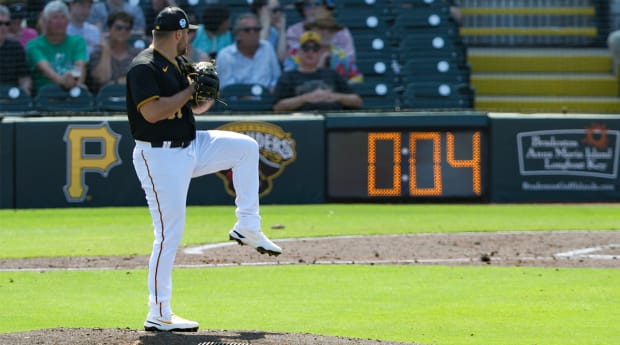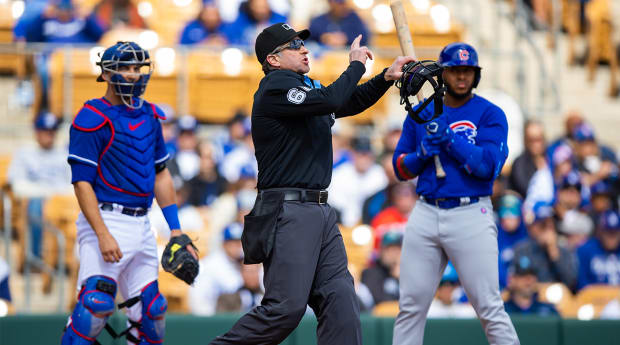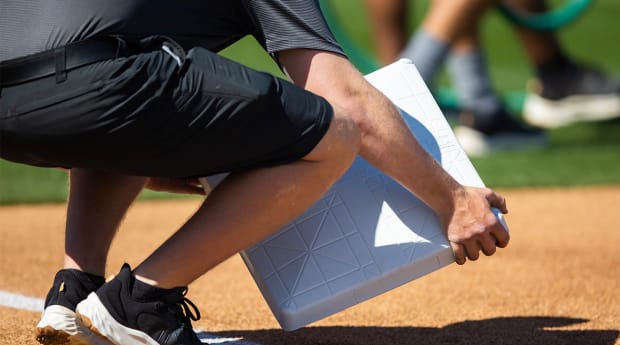You can tell baseball looks very different this year just from the first weekend of spring training games. As in 1920 (Live Ball Era), ’61 (Expansion Era), ’73 (DH Era) and ’95 (Wild-Card Era), 2023 brings such monumental, permanent change that the start of a new era is visible.
It starts now. Are you ready?
You’ve got questions about the new rules. I’ve got answers.

Nathan Ray Seebeck/USA TODAY Sports
Question: It seems like pitch-timer violations happen a lot. How much are these violations going to disrupt the game?
Answer: Relax. You are hyperaware of such calls right now because they are novel. And you’re looking at a transitional phase—dress rehearsal, if you will—as players adjust.
The adjustment will be quicker than you think. Last season under these rules minor leaguers started the first month with slightly fewer than two violations per game. By the sixth week it was under one per game. By midseason it was down to less than 0.5 per game. A poll by MLB found 89% of minor leaguers said it took a month or less to get accustomed to the new rules.
Even better news: The minors did not use the rules in spring training last year as a ramp-up to playing baseball with a timer. They began cold turkey. Major league teams have a month of spring training to adjust before Opening Day.
Pitch-timer violations will be less common than balks.
Q: How much time will be cut from a game?
A: About 20 minutes. In the minors, the pitch timer cut 25 minutes off the average time of game, down to two hours, 38 minutes. That’s asking a bit much in the majors, because the major league timer is one second longer and because the usual 2:15 inning breaks in the majors extend to 2:40 for national TV games and 3:10 in the postseason.
The average time of a major league game this decade is three hours, three minutes. It should drop this year to about 2:44, which is what it was in the 1980s. Based on polling of fan preference, MLB would love a 2:30 average eventually.
Q: Is time of game the biggest reason for these changes?
A: No. There is an even more important reason: pace of action.
The average game time has not been at or below 2:45 since 1985. More importantly, watching a game in 1985 you saw a ball in play every two minutes, 55 seconds. Last year the average wait was 3:49. The pace of action last year was 31% slower than what it was in 1985—with fewer runs!
Yes, the rule changes will help get a family home from the ballpark at a decent hour on a school night. Yes, they will curtail the reputation baseball has as the only sport in which paying customers leave a competitive game because it is taking too long.
Above all, they are about playing the game in a heightened sense of readiness. For fans that means obvious visual and psychological change. The visual change will be players in ready position rather than dawdling. The psychological change will be more engagement knowing the next pitch, the next ball in play or the next stolen base is coming quicker.
More than any other sport, baseball thrives on anticipation. But it drove away fans because those gaps in action became too long to hold interest.
Q: Why don’t they just let the game self-correct and stop over-regulating it?
A: Tried it. They’ve done that for years and lost almost 15 million paid customers since 2007 while the game continued in the same direction: slower with less action. As Gerrit Cole of the Yankees said at the All-Star Game last year when asked about the pitch timer coming to the game, “I think it needs it, obviously. And I think it’s coming regardless of the opposition by the players. It’s kind of our fault. We’ve known it’s been an issue and its importance and we don’t seem to clean it up.”
Q: Will the World Baseball Classic use these new rules?
A: No. It would be too hard to get all the international baseball federations to impose these changes for one tournament. Major leaguers in the WBC will play under two sets of rules this spring.
Q: Will these rules apply to the postseason?
A: Absolutely. This is not like the rule that puts a runner on second base in extra innings, which goes away in the postseason. (Its primary purpose is to save roster chaos caused by long games, which is not an issue in the postseason.) The pitch timer is designed to address pace of action and length of game, both of which are exacerbated in the postseason. MLB believes the rules are even more important in the postseason.
Q: Who will have more trouble adjusting to the timer, pitchers or hitters?
A: Pitchers, at least if you follow the minor league data. Among pitch timer violations last season, 81% were by the pitchers.
Q: What happens if a manager argues a pitch-timer violation?
A: Automatic ejection, same as with arguing a replay decision. Remember, the entire premise is built on speeding up the game.

Mark J. Rebilas/USA TODAY Sports
Q: Doesn’t this put more authority in the hands of umpires?
A: Yes, in a very strict sense. Umpires have been instructed to enforce pitch-timer and balk rules as close to the letter of the law as possible. No “grace periods” or going by “feel.” But they also are instructed to use common sense when necessary. If a batter gets something in his eye, for instance, the umpire will stop the clock and reset it. Health and safety come first. Gamesmanship will not be tolerated.
Q: Did you see a Boston-Atlanta game ended on a pitch-timer violation? Come on. What’s up with that?
A: The clock doesn’t care who or when. Again, when you start giving umpires discretion, you’re asking for trouble. The batter taking too long to get ready to hit is no different than a shot-clock violation in the NBA, play-clock violation in the NFL or slow-play penalty in golf. It’s not the rule’s fault; it’s the player’s fault.
Q: When does the pitch timer start?
A: When the return throw from the catcher hits the pitcher’s glove. Pitchers who walk halfway to the plate probably should break that habit; while they are walking back to the mound after getting the return throw the clock will be running. Catchers may learn not to return the ball so quickly as to give their pitchers a few more seconds of recovery. Keep in mind umpires are empowered to call any violations if they judge players are “gaming the system” with obvious such workarounds.
Q: What kind of hacks are pitchers going to come up with?
A: The rules have been tested over more than 8,000 minor league games, so we know what’s coming. With runners on, pitchers will come to the set position quickly, to “freeze” the batter, who must be alert and ready with eight seconds on the timer. That’s a long time for a hitter to be ready without acquiring tension in his body.
Pitchers came set early in the minors also to make sure runners don’t time the pitch timer. As the clock is about to hit zero, the runner knows the pitcher must go home—like a defensive lineman who sees the play clock in football reaching zero.
Pitchers also will tend to keep their second pickoff throw in their back pocket as leverage. It will be fascinating to see how many runners go on first move after a first pickoff, knowing most pitchers will not want to burn their two allotted pickoffs back to back.

Mark J. Rebilas/USA TODAY Sports
Q: What kind of effect will the bigger bases have?
A: Probably not as much as you think, at least not right away. Infield hits went up 1% to 2% in the minors. Coupled with the limit of two pickoff throws per plate appearance, stolen base attempts went up 26% compared to 2019. That would mean 857 more steal attempts in the majors, or 0.35 more per game.
But that should pick up over time. As the stolen base success rate improves, and as the rules promote more athleticism, front offices will put greater value on speed in drafting and developing and lose a bit of their risk aversion when it comes to outs on the bases.
Q: Infielders must start inside the outer perimeter of the infield arc and no more than two on each side of second base. But can the shortstop run to the right side of the field or the second baseman run into the outfield as the pitcher starts his delivery?
A: No. The “man in motion” concept is a violation. It is a clear thumbing of the nose at the spirit of the rule.
Q: Can I move my infielders to different positions during an inning?
A: No—only if there is a substitution. No more standing around waiting for the third baseman to jog across the diamond to play right side rover, and then waiting for him to come back again.
Q: Can my left fielder play the rover position against a lefty, essentially re-creating the shift?
A: Yes. There are no governors on outfield positioning. But the risk-reward of that alignment is so unfavorable you will not see it often. With left field uncovered, the opposite-field bloop or flared pop-up becomes an embarrassing triple. Two outs, bases empty, severe pull hitter at the plate may be one scenario where you see it.
Q: So, wait: you’re telling me we’re looking at a game with more hits, more runners and more steals and it will take 20 fewer minutes?
A: Bingo.
Q: Sign me up. One more question.







